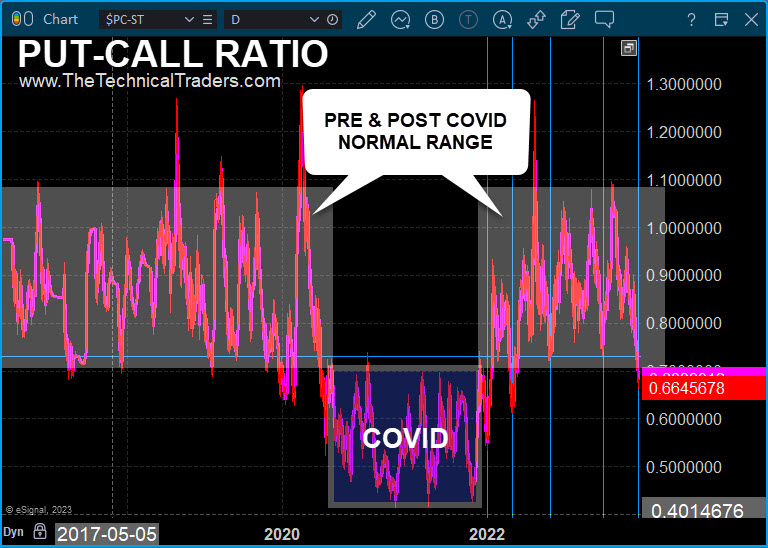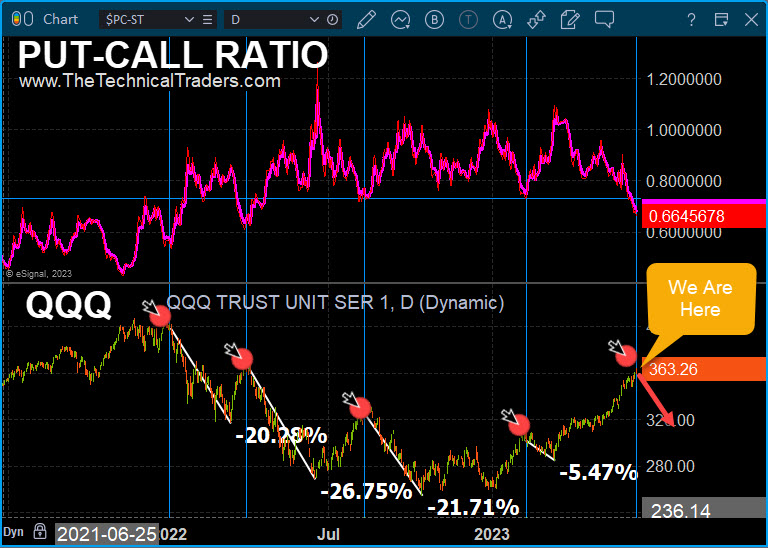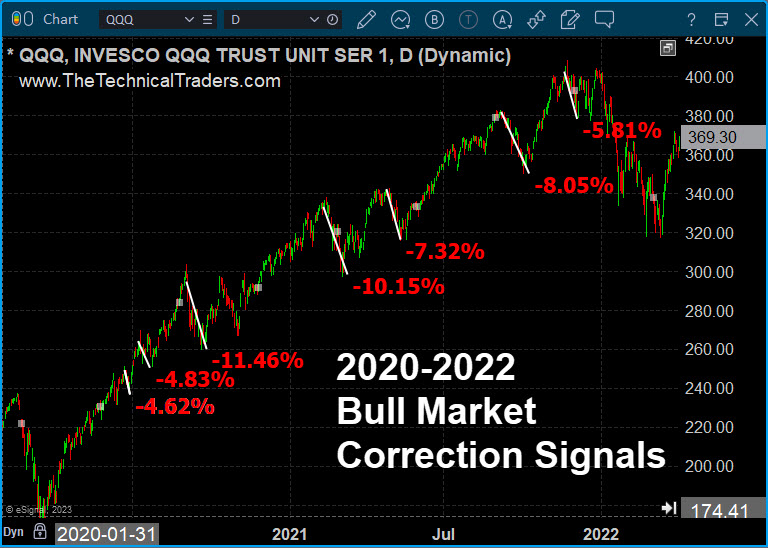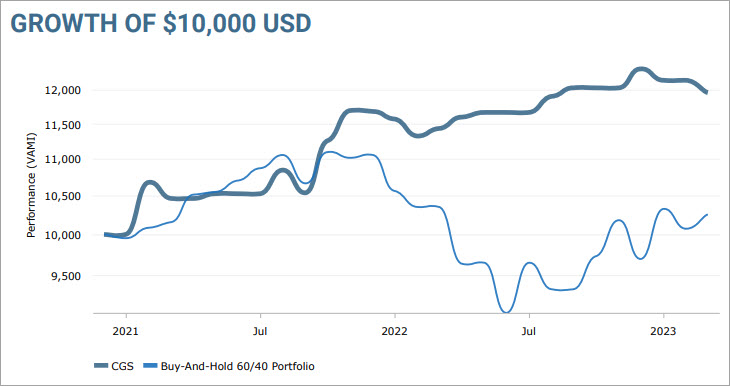In the dynamic world of trading and investing, the COVID-19 pandemic has served as a transformative catalyst. Market behaviors, trader attitudes, and even commonly used indicators underwent seismic shifts during this period.
In this discussion, we delve into the multifaceted comparison of trading and investing practices before, during, and after the COVID-19 pandemic, focusing on the put-call ratio, cycle analysis, and their influences on stock market trends.
Pre-COVID Trading
Before the pandemic, trading was characterized by an element of predictability and stability. The market was largely navigated by seasoned traders who relied on a mix of sentiment, fundamental, and technical analysis.
A useful indicator was the put-call ratio—an index that offered insights into market sentiment by comparing the volume of bearish put options to bullish call options. This ratio was a reliable barometer of overbought and oversold market conditions, hinting at times when the market was excessively optimistic (frothy) or pessimistic.
In an overbought scenario, for instance, the ratio would be skewed towards calls and would have a low value, often leading to market corrections and providing savvy traders with cues for profitable entry and exit points.

Trading During COVID 2020-2022
With the advent of the COVID-19 pandemic, the stock market experienced an influx of new participants. As lockdowns were implemented globally, traditional avenues for entertainment and engagement were suddenly curtailed. Consequently, a myriad of individuals, many of whom were novices, pivoted toward the stock market.
Interestingly, these new market participants demonstrated a marked propensity for risk-taking, often opting to buy call options. This surge in call options buying—partially due to their relatively low cost and high potential return—significantly distorted the put-call ratio, driving it below its typical range.
During this period, the put-call ratio lost its utility by mid-2020. The usual overbought and oversold signals it generated became unreliable due to the influx of inexperienced traders and the consequent rampant purchasing of call options.
Trading Post-COVID Put-Call Ratio
In early 2022 after the majority of novice traders lost money from falling prices in growth stocks and gave up, the put-call ratio returned to normal. As global societies gradually adjusted to the realities of a post-pandemic world, so too did the stock market. The put-call ratio climbed back to its prior averages, once again serving as a useful tool in identifying potential market tops and forecasting corrections. With the options market behavior reverting to more predictable and recognizable patterns, we can effectively apply technical analysis and anticipate potential pivot points with the options market once again, as seen in the chart below.
After COVID, the QQQ has exhibited an interesting trend where the put-call ratio and a cycle market top signal have aligned for the first time together. Given that the average market correction post-COVID has been approximately 18.5% to the downside, this unprecedented alignment of signals suggests that a similar pullback could be imminent.

Trading the QQQ Pre-COVID
The Nasdaq 100 (as represented by the QQQ) was characterized by standard cyclical behavior. Using techniques like cycle and intermarket analysis, traders could effectively identify times when the market was oversold or overbought. The typical market correction during this time was roughly 6%. These insights informed a technical trader about possible pullbacks or market advances, contributing to strategic decision-making processes.

The Double Sell Signal for QQQ
Analyzing the QQQ provides valuable insights into the stock market’s health. A unique phenomenon has been observed in the post-COVID market, where the put-call ratio and market top signals from the QQQ align. The put-call ratio, falling below its established average range, indicates a market teetering on overbought conditions. Concurrently, the QQQ cycle and intermarket analysis are giving me a topping signal as well.
Despite the broader market’s positive momentum, signs of divergence have become noticeable. Major indices are primarily propelled by a handful of heavyweight companies, masking the underperformance of individual stocks in the broader market. As these market leaders begin to lose momentum, the market as a whole could face a significant pullback, ranging from a 6% to 26% drop in the coming weeks.
The fed and other economic data could send stocks into a final exhaustion push higher. If that happens, it means an even sharper correction afterward is likely to take, so be aware, and don’t get sucked into the market just before it reverses.

How to Trade Rising and Falling Markets
Trading in bull and bear markets requires distinctly different strategies. In bull markets, the focus is on identifying potential market tops and managing positions during pullbacks. In contrast, in bear markets, traders look for signals indicating that the market is oversold and ready for a bounce.
Rising markets are fairly simple and much slower than falling prices which are violent and require active intraday position management. Also, different sets of data and indicators are needed to trade rising and falling markets, which is where most individuals get things wrong. They use the same strategy in totally different market environments, and that’s a recipe for underperformance and substantial losses.
How You Can Trade and Invest Differently
Trading and investing are lifelong learning journeys. Developing a comprehensive understanding of market dynamics, technical analysis, position management techniques, and having the proper expectations are the keys to enhancing your trading and investing success.
Two valuable techniques are cycle and intermarket analysis, for understanding market ebbs and flows, and the other is position and risk management. The effective style of investing that I use is asset revesting—investing only in assets that are rising. This strategy helps to avoid holding assets that are depreciating and minimizes exposure to significant losses, enabling your account to consistently grow and hit new highs. In fact, during 2022, when nearly all investors were down 15%- 25%, the CGS Asset Revesting Strategy I followed kept growing my account, reaching new high watermarks every few months. Asset Revesters and I know the value this style has over the traditional buy-and-hold method and cringe every time we hear of a retiree who has their life savings tied up in a diversified buy-and-hope strategy.
Managing Risk Vs. Buy-and-Hold Investing
Simply put, asset revesting is the total opposite of buying-and-holding. Its number one goal is to protect your wealth and lifestyle first, then look to generate profits second. It just happens that by avoiding big losses, the returns with this strategy are nearly 3x that of the traditional method.

Concluding Thoughts
By using appropriate trading and investment strategies for the current market conditions, you can improve your market performance and reduce your risk and losses. Remember, while the market’s overall trajectory is still upward, preparedness for corrections is vital as it could be a correction of 5% or 50% – no one knows until after it has happened. That is why it’s crucial to have an exit strategy and to take profits when signs point to a potential market correction like this. The goal is not just to survive but to thrive in any market condition.
